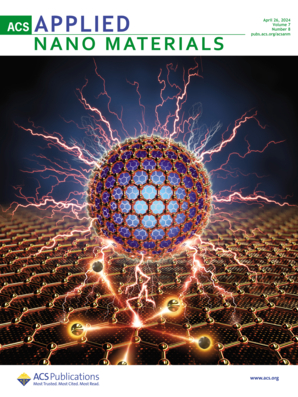通过原位诱导剪切应力调整三维打印 PVDF-MoS2 纳米复合材料的压电特性
IF 5.3
2区 材料科学
Q2 MATERIALS SCIENCE, MULTIDISCIPLINARY
引用次数: 0
摘要
三维打印具有可调特性的独特结构为制造复杂的定制电子设备提供了显著优势。本研究介绍了一种工艺-微结构-特性引导的制造路线,无需后处理即可制造出具有可调压电特性的 PVDF-2D MoS2 压电纳米复合材料。我们通过直接墨水写入(DIW)三维打印技术控制 PVDF 的微观结构,同时通过控制流变学和三维打印参数(如喷嘴尺寸和打印速度)来调整 PVDF-MoS2 的界面应变。我们的方法证明了 PVDF-MoS2 的可调压电性,在 6685 Pa 的打印诱导剪切应力下,压电系数(d33)增加了 15 倍。这种增强源于 PVDF 和 MoS2 之间的静电相互作用,以及三维打印中原位剪切应力引起的填料分布和排列,XPS 和拉曼图谱分析证实了这一点。我们的研究结果加深了人们对基于 PVDF 的纳米复合材料中压电机制的理解,为可穿戴设备应用中压电传感器的三维打印奠定了基础,并提高了性能和定制能力。本文章由计算机程序翻译,如有差异,请以英文原文为准。

Tailoring Piezoelectricity of 3D Printing PVDF-MoS2 Nanocomposite via In Situ Induced Shear Stress
3D printing of unique structures with tunable properties offers significant advantages in the fabrication of complex and customized electronic devices. This study introduces a process-microstructure–property-guided manufacturing route to fabricate PVDF-2D MoS2 piezoelectric nanocomposites with tunable piezoelectric properties without having a postprocess. We control PVDF’s microstructure through direct ink writing (DIW) 3D printing while tuning PVDF-MoS2 interfacial strain by controlling rheology and 3D printing parameters, such as nozzle size and printing speed. Our approach demonstrates tunable piezoelectricity in PVDF-MoS2, achieving a 15-fold increase in the piezoelectric coefficient (d33) at a printing-induced shear stress of 6685 Pa. This enhancement arises from the electrostatic interactions between PVDF and MoS2 and the filler distribution and alignment caused by the in situ shear stress in 3D printing, as confirmed by XPS and Raman mapping analyses. Our findings advance the understanding of piezoelectric mechanisms in PVDF-based nanocomposites, laying the foundation for 3D printing of piezoelectric sensors in wearable device applications with enhanced performance and customization capabilities.
求助全文
通过发布文献求助,成功后即可免费获取论文全文。
去求助
来源期刊

ACS Applied Nano Materials
Multiple-
CiteScore
8.30
自引率
3.40%
发文量
1601
期刊介绍:
ACS Applied Nano Materials is an interdisciplinary journal publishing original research covering all aspects of engineering, chemistry, physics and biology relevant to applications of nanomaterials. The journal is devoted to reports of new and original experimental and theoretical research of an applied nature that integrate knowledge in the areas of materials, engineering, physics, bioscience, and chemistry into important applications of nanomaterials.
 求助内容:
求助内容: 应助结果提醒方式:
应助结果提醒方式:


